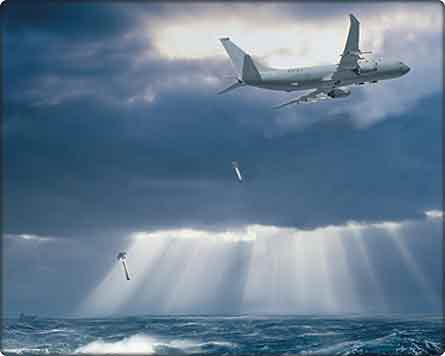A competition is quickly forming to design and build a new weapon that will enable the future US Navy Boeing P-8A Poseidon fleet to attack submarines without first descending to low altitude.
Boeing, Lockheed Martin and Raytheon are among the most likely competitors for the contract to develop the high-altitude, anti-submarine weapon concept. This will essentially be a Raytheon Mk54 torpedo modified with a wing kit, datalink and flight controls.
A request for proposals is scheduled for September, with contract award likely to follow in the second quarter of 2009, according to an industry source. The completed weapon would be installed as part of the first package of upgrades planned for the P-8A after 2014.
 |
|---|
© Boeing |
The USN has been working on the concept for the past few years. Airframe fatigue for the P-8A's ageing predecessor - the Lockheed P-3C Orion - is partly blamed on the need to practise, descending to low-altitude to release torpedoes.
The navy also wants to keep the P-8A at high altitude so the aircrew can continue monitoring the airspace and maritime environment for new threats.
Lockheed's design consists of connecting a wing kit to a Mk54 using two metal bands. As the weapon descends to the surface, a pyrotechnic device dislodges the bands to allow the torpedo to jettison from the wing kit. After designing the weapon for the P-3C, Lockheed recently showed that a new version adapted to fit inside the P-8A's weapons bay can be launched at maximum range and altitude from the target.
Raytheon is also understood to have demonstrated a similar capability, releasing a guided Mk54 from a Beechcraft King Air in the second quarter of this year, and Boeing is also expected to compete for the same contract.
"We know it's going to be a competition," says Richard Fry, Lockheed's business development manager for area attack weapons.
Source: Flight International























